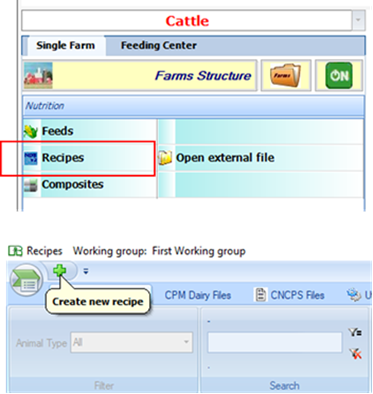
Based on the NRC 2001 framework, which established a good foundation for energy and protein requirements of calves, NDS Calf Model represents a useful approach and enhancement in our understanding, to feeding young calves.
It employs a more mechanistic approach to the accelerate calf growth and development than previously utilize because it is working with on updated data based on further studies at Cornell and Illinois University (Van Amburgh and Drackley, 2005).
Energy requirements have also been refined:
•One adjustment has been to scale for surface area to account for the additional heat loss due to body size.
•A second adjustment has been made to account for conditions outside thermoneutral temperature so that for every degree below thermoneutral the energy requirement increases.
With the adoption of this tool will be encouraged the re-evaluation of one-size fits all approach to calf feeding that currently exists.
NDS Calf Model provides reasonable estimates of the animal’s nutrient requirements and is consistent with the remainder of the publication regarding tabular values and estimates of nutrient requirements. The estimates of energy requirements for young calves are more consistent with existing literature and can provide dairy professionals with legitimate means to model dairy animal growth and select management strategies to optimize profitability.
NDS Calf Model is integrated into the NDS Professional platform and for access to it, you can create a New Recipe for Young Calf animal type.

Select Young Calf as animal type
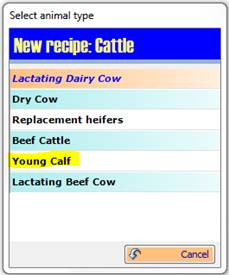
It will open the default Animal inputs screen for Young Calf where you can set up the proper animals data.
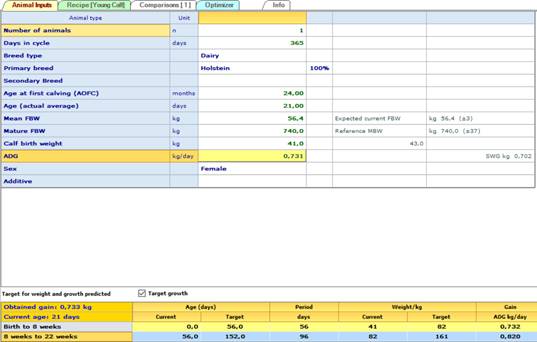
Then, including any kind of calf feed into the Recipe screen, you can get the diet evaluated according to the model for energy, protein, minerals, and vitamins.
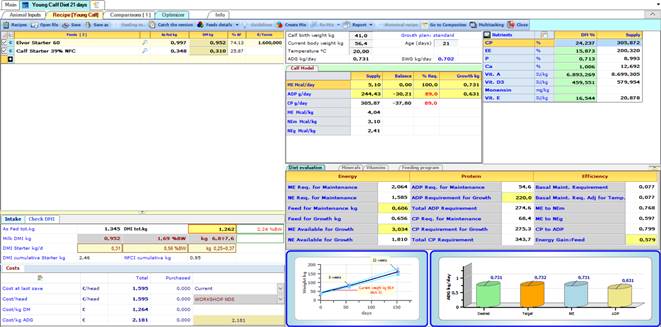
During the formulation process, the model provides some guidelines and information:
− Milk DMI: intake of milk or milk replacer predicted as kg (or lbs) per day and as % of BW
− Amount of fluid milk replacer to get a total solids content of 12.5 to 14% in order to ensure an adequate osmolality
− Starter consumption: starter consumption predicted as kg (or lbs) per day and as a percentage of BW, with the min and max intake expected according to starter characteristics (texture, palatability, etc.)
− Cumulative calf starter DMI and NFC: cumulative intake of NFC from calf starter appears to be a critical factor in the development of digestibility of NDF and NFC and, thus, the energy content in calf starter. The NFC intake seems to be related to gastrointestinal development which becomes more and more able to extract energy from dry feeds (Quigley et. al., 2019).

Calf starter nutritional contribution
It is well established that intake of calf starter is critical to ensure adequate rumen development and growth during the first few months of life.
Even though prediction of starter intake on an individual farm will probably differ from another, due to many factors that can influence calf starter intake, this prediction can give us an indication of the potential for the intake of dry feeds in calves. Given that the fermentation of carbohydrates early in life initiates rumen development, the intake of starter accelerates the time at which calves are prepared for weaning.
However, based on recent research (Quigley et. al., 2019), equations to calculate dietary energy in current models of nutrient requirements for calves (NRC, 2001) do not reflect changing digestibility in young calves and, therefore, may overestimate the contribution of calf starter and other dry feeds to total nutrient supply in the first months of life. As these observations are in agreement with clear field evidence, we decided to partially modify the Calf Growth Model, specifically in the section concerning the nutritional evaluations of the dry feed associated with milk replacers.
The approach proposed by Quigley et. al., 2019 was then followed. It suggests that cumulative exposure to fermentable carbohydrate may be an important criterion for determining the maturation of the gastrointestinal tract in general and the rumen in particular and is consistent with current theories regarding the importance of fermentable carbohydrate to initiate rumen development (Baldwin et al., 2004; Khan et al., 2016).
While nothing has changed for milk replacer evaluation, the changes made consist mainly in new estimates focused on a more accurate evaluation of the energy content of calf starter. Based on this new approach, the energy content of calf starter it is not constant but increases with increasing NFC intake supplied by dry feeds.
Diet Evaluation
NDS Calf Model provides also detailed information about maintenance and growth requirement for Energy and Protein, as well as for the efficiency of utilization of the diet.
 |
Some charts help to better understand the dynamics of growth up to 5 months (target vs. desired) as well as the predicted growth.
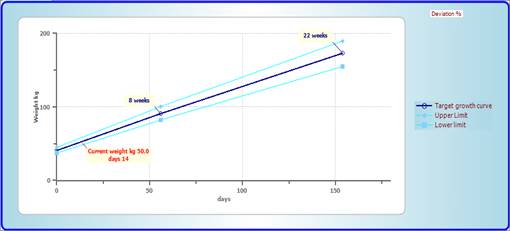
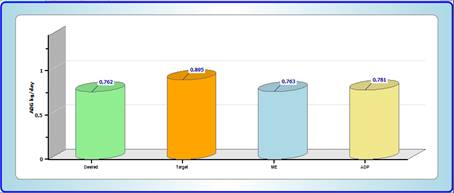
Minerals and Vitamins
Likewise, are provided details about requirements and supply for minerals and vitamins.
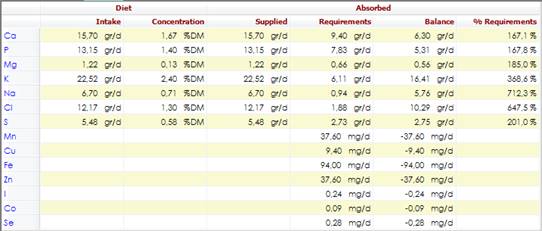
Calf Feeding Program
Early weaning requires that a specific feeding program be adopted in order to get a rapid development of the young animals, minimizing health problems.
The Feeding Program tab within NDS Calf Model is designed to provide a feeding plan, consistent with the goals above, from birth to weaning.


Based on current animal inputs, the feeds included in the diet and some additional inputs, the feature propose a weekly plan for feed delivering from post-colostrum time to the weaning.
The additional info required are:
− Meals - number of milk feeding per day
− Weaning age - the average age in days at which calves are weaned off milk
− Milk replacer solid content - is the targeted total solids content of milk replacer. In order to maintain the proper osmolarity total solids should be between 12.5 to 14%.
− Milk supply plan - Flat when milk is supply at the same amount through the entire period, while Weekly means that the amount is defined on a weekly base according to the requirements.
The outcomes of the tab on a weekly basis include:
− Milk replacer amount suggested – milk powder and amount of water needed to get the desired solid concentration
− Calf starter expected intake
− Expected gain per day
− Feeding costs – both per head and per kg or lbs of ADG
Implications
Among of the most overlooked groups of animals on a dairy farm are both the milk-fed and transition calf and, as stated by Mike Van Amburgh, “A re-evaluation of our calf programs suggest that new nutritional and management guidelines should be developed in an effort to improve calf growth and survivability”.
NDS Calf Model is an evolved tool able to help in making more accurate decisions about young calf nutrition. It allows a more mechanistic approach to “ration formulation” for young calf and has the goal to cover the lack of tools for calculating nutrient requirements and supply.
Only developed into the NDS platform, it is implemented with new data available that suggest what we can do in the first few weeks of life to achieve long-term impacts on animal productivity.
NDS Calf Model employs a more mechanistic approach to calf growth and development than previously utilized and with its adoption, we would like to encourage the re-evaluation of the one-size fits all approach to calf feeding that currently exists.